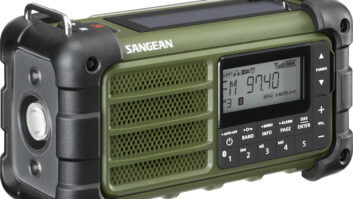Standards. Out here in the engineering world (regardless of the discipline), we live (or die) by standards.
This issue of RWEE has something of a standards theme, featuring an article and a white paper dealing with some fairly recent standards with which broadcast engineers have to deal on a regular basis.

As I was putting the issue together and thinking about standards, I glanced over at my bookcase and realized that it is well stocked with standards of various sorts. A few examples:
• ANSI/TIA-222-G Tower Structural Standard (I haven’t spent the big bucks for a copy of Revision H yet)
• Various volumes containing antenna modeling standards
• NRSC-5 IBOC Standard
• NAB Engineering Handbook (11 Edition)
• SBE Broadcast Engineering Handbook
• The ARRL Handbook for Radio Communications
• Handbook of Electronic Tables and Formulas
• Terman’s Radio Engineering and Radio Engineer’s Handbook
• Various volumes containing NEPA, NPA and FAA rules and standards
• Several volumes containing penal code and other law enforcement standards (left over from another life when I worked in law enforcement)
• The Aeronautical Information Manual
While I long ago made the move to an online FCC rule and case law resource, I still have three thick hard-bound volumes containing select parts of the FCC Rules. One of the three volumes is titled “FCC Standards,” and contains engineering standards of allocation for AM, FM and TV (from the early 1980s).
And somewhere around here, along with a collection of IEEE white papers from decades ago, I have a long-out-of-print booklet, “The Standards of Good Engineering Practice Concerning Standard Broadcast Stations” (1939).
All of these, to some degree or another, define what we do and how we do it. They’re like the stripes on the pavement or roadside signs. Without them, we are left with a form of anarchy — everyone does their own thing, and everyone’s “thing” is different from everyone else’s. Predictably, this can result in chaos. Things that work at all usually take a lot longer to complete or are of such poor quality that they don’t last or are not reliable.
As a pilot, I am very glad that the aircraft I fly are built and maintained to a set of rigid standards. As an airline passenger, I’m grateful for the same things, and that the crew flying the plane is trained to a set of rigorous standards. As a driver, I’m grateful for no-passing zones, speed limits and lane markers.
Thankfully, in broadcast engineering, we do have a set of standards for most of what we do, a roadmap to doing it right and in a manner that will result in predictable, reliable operation.
Some of these standards have the force of law — FCC allocation standards, for example, wherein protected and interfering contours, power levels, modulation, occupied bandwidth and other parameters are prescribed by statute. Other broadcasters and equipment manufacturers can hang their hat on these, knowing that we’re all playing by the same set of rules.
Other standards don’t have the force of law — they are voluntary, but they nonetheless provide a framework within which we should operate. For example, in the world of antenna modeling, there are certain “rules” that should be observed, such as maintaining similar segment lengths between wires. By observing these rules, the engineer has a certain degree of assurance that the model will behave in a predictable way.
In last December’s RWEE, in a brief discussion of the new TIA-222 Revision H tower standard, I noted that in some venues, that standard does have the force of law, and that remains true.
In a tower project in Southern California a few years ago, the building department required me to purchase a copy of the ANSI-TIA-222-G standard and provide it to them so that the plan checker could verify that the tower design was made in accordance with the standard.
If there had been a deviation, I’m fairly certain that the permit would not have been issued. But even in venues where compliance with the TIA standard is not a requirement, adhering to it provides us with reasonable assurance that a tower will safely support its design load in all anticipated site conditions.

While I haven’t had any direct experience with it — yet — I think the AES67 standard is a marvelous thing. It will open the door for interconnection between different AoIP systems. I can, if I wish, use Axia (or other) gear on a Wheatstone system, or Wheatstone (or other) gear on an Axia system, taking and routing the source and destination streams as if they were native. That, in my view, is a very good thing. Both manufacturers make excellent equipment, but Axia makes gear that Wheatstone does not and vice versa. I can have the best of both worlds while retaining routing capability. This would not be possible without a defined standard.
We also have standards within our company. We use a similar complement of equipment in each location, and the nomenclature, IP addressing scheme and overall infrastructure designs all adhere to this standard.
Even the color of the various cables adhere to an internal standard — orange-jacketed Ethernet cable always carries AoIP, yellow-jacketed Ethernet cable is on the engineering network (carrying automation and transmitter site traffic), and blue-jacketed Ethernet cable is on the office network. For digital and analog audio, violet-jacketed wire is 110-ohm AES cable carrying AES digital audio signals, gray wire is left channel and black wire is right channel. Red wire is logic — remote starts, tally signals, etc. And everything uses a 44.1 kHz sample rate.
Any engineer in our company can come into any of our facilities and at the very least, know by the color of a wire what its general function is. He or she will be unlikely to plug an automation computer into the office or AoIP networks. He or she can also know the general network and facility infrastructure and follow wire and routing lists to find or trace a signal through the system. The facilities are all purpose-built — they are anything but cookie-cutter copies of one another — however, the underlying infrastructures all adhere to a general set of standards.
My point here is that there is great value in developing and adhering to standards in our work. We don’t really have any choice where it comes to mandatory standards such as the FCC rules, but we can take or leave voluntary standards.
While we may find that standards constrain us to some degree, they can also make our work easier and more orderly, and they permit us to do things that would otherwise be impossible. In my book, that makes them worthwhile.
Cris Alexander, CPBE AMD DRB, is director of engineering of Crawford Broadcasting Co. and technical editor of RW Engineering Extra.












